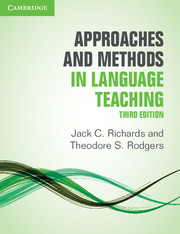Book contents
- Frontmatter
- Contents
- Acknowledgments
- Introduction to the third edition
- I Major trends in twentieth-century language teaching
- II Current approaches and methods
- III Alternative twentieth-century approaches and methods
- IV The teaching and learning environment
- Appendix: Comparison of approaches and methods
- Author index
- Subject index
I - Major trends in twentieth-century language teaching
Published online by Cambridge University Press: 08 April 2022
- Frontmatter
- Contents
- Acknowledgments
- Introduction to the third edition
- I Major trends in twentieth-century language teaching
- II Current approaches and methods
- III Alternative twentieth-century approaches and methods
- IV The teaching and learning environment
- Appendix: Comparison of approaches and methods
- Author index
- Subject index
Summary
Language teaching came into its own as a profession in the twentieth century. The whole foundation of contemporary language teaching was developed during the early part of the twentieth century, as applied linguists and others sought to develop principles and procedures for the design of teaching methods and materials, drawing on the developing fields of linguistics and psychology to support a succession of proposals for what were thought to be more effective and theoretically sound teaching methods. Language teaching in the twentieth century was characterized by frequent change and innovation and by the development of sometimes competing language teaching ideologies. Much of the impetus for change in approaches to language teaching came about from changes in teaching meth-ods. The method concept in teaching – the notion of a systematic set of teaching practices based on a particular theory of language and language learning – is a powerful one, and the quest for better methods was a preoccupation of many teachers and applied linguists throughout the twentieth century. Methods typically make the same claim, namely that they reflect a correct understanding of language learning and that adopting the newest method will lead to better results than the method that preceded it. The chapters in Part I examine the developments that led to the first major paradigm in modern language teaching – the adoption of grammar-based teaching methods that came to be known as the structural approach or Situational Language Teaching in the United Kingdom, and Audiolingualism in the United States. In Chapter 1, we outline the historical precedents to language teaching in the first part of the twentieth century and provide a rationale for the study of approaches and methods and their impact on trends and practices in language teaching. In Chapter 2, we introduce a model, or framework, for the description of approaches and methods, one that identifies three levels of organization underlying approaches and methods that we refer to as approach, design, and procedure. These levels of organization are used throughout the book. In Chapter 3, we describe one of the most important British language teaching proposals of the twentieth century, the Oral Approach or Situational Language Teaching, a method that continues to be widely used today in textbooks and teaching materials, though in the somewhat modified form of Presentation-Practice-Production, or PPP.
- Type
- Chapter
- Information
- Approaches and Methods in Language Teaching , pp. 1 - 2Publisher: Cambridge University PressPrint publication year: 2014

